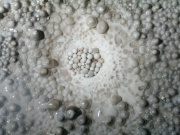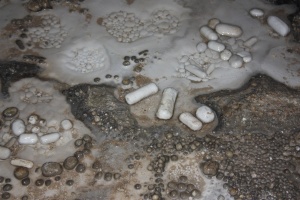Calcite (Inventory)/Pearl
From LagWiki
(Move the gallery) |
|||
| (10 intermediate revisions not shown) | |||
| Line 1: | Line 1: | ||
| - | + | {{Inventory image|File:Cave Pearls.jpg|Typical nest of cave pearls}} | |
| + | Cave '''pearls''' are small balls of [[Calcite (Inventory)|calcite]] or [[Aragonite (Inventory)|aragonite]] that usually form on the floor in shallow pools or depressions. They are formed from constant, steady dripping action causing agitation of a small seed crystal building up layers of calcite. They can occur singularly in depressions in the bedrock but are usually found in nests. Some of the pearls may become cemented into the floor. Cave pearls need not always be round. Sometimes they can have a cylindrical shape. The size varies from very small but rarely gets much larger than a golf ball or small egg. Most are pea to marble sized. Nests of pearls can easily be obscured by mud or silt. Great care should be taken not to disturb them during a survey. | ||
| - | + | Cave pearls are not to be confused with [[Bedrock (Inventory)/Pisolites|pisolites]]. | |
| - | + | ==See also== | |
| + | *[[Bedrock (Inventory)/Pisolites|Pisolites]] | ||
| - | + | ==References== | |
| - | + | ||
| - | + | ||
| - | + | ||
*Palmer, Arthur N. (2007) ''Cave Geology'' CAVE BOOKS, Dayton, OH p 280 ISBN-13: [[Special:Booksources/978-0-939748-66-2|978-0-939748-66-2]], ISBN-10: [[Special:Booksources/0-939748-66-5|0-939748-66-5]] | *Palmer, Arthur N. (2007) ''Cave Geology'' CAVE BOOKS, Dayton, OH p 280 ISBN-13: [[Special:Booksources/978-0-939748-66-2|978-0-939748-66-2]], ISBN-10: [[Special:Booksources/0-939748-66-5|0-939748-66-5]] | ||
| - | < | + | |
| + | ==Pearl, Calcite== | ||
| + | <gallery perrow=1 widths=300px heights=200px> | ||
| + | File:Cylindrical cave pearls.JPG|Cylindrical cave pearls | ||
| + | </gallery> | ||
| + | |||
{{Cave inventory}} | {{Cave inventory}} | ||
| - | |||
Current revision as of 22:12, 9 August 2013
Cave pearls are small balls of calcite or aragonite that usually form on the floor in shallow pools or depressions. They are formed from constant, steady dripping action causing agitation of a small seed crystal building up layers of calcite. They can occur singularly in depressions in the bedrock but are usually found in nests. Some of the pearls may become cemented into the floor. Cave pearls need not always be round. Sometimes they can have a cylindrical shape. The size varies from very small but rarely gets much larger than a golf ball or small egg. Most are pea to marble sized. Nests of pearls can easily be obscured by mud or silt. Great care should be taken not to disturb them during a survey.
Cave pearls are not to be confused with pisolites.
See also
References
- Palmer, Arthur N. (2007) Cave Geology CAVE BOOKS, Dayton, OH p 280 ISBN-13: 978-0-939748-66-2, ISBN-10: 0-939748-66-5
Pearl, Calcite


